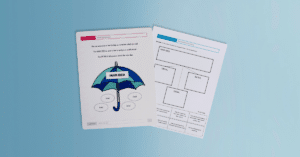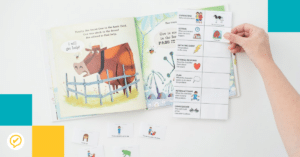This is a guest blog post by Monica, a school-based SLP, all about how to pick a service delivery model!
How to Choose A Service Delivery Model
Deciding on a service delivery model and how many minutes you suggest at a meeting can be one of the most complex decisions you make during the IEP process. Hopefully, this post will help give you a sense of the options out there and expand your choices beyond 30 minutes, twice a week in the speech room!
First things first! Be ready to be flexible at the IEP meeting. Service minutes should never be predetermined before a meeting. Your recommendation may have to be adjusted based on what you learn at the meeting. There are a lot of different factors that drive the final decision! With that being said, let’s dive in.
Service Delivery 101
Service times and service delivery are built around goals and drive that recommendation. Here are some of the factors that you may consider:
1. How many goals are being targeted?
2. What intensity is required to achieve the goal(s)?
3. Will the goals will generalize outside of your speech room?
4. What does the research recommend?
5. What are the student’s feelings and personality/temperament?
6. What supports does a student need to be successful?
7. What is the school’s schedule?
8. What input do parents and teachers have?
Considering all of these factors helps maintain an evidence-based practice (EBP) lens when you’re making decisions about service delivery.
1. How many goals are being targeted?
Deciding how many goals to target can be a tough decision to make.
I always go back to Common Core Standards and target the goals that will make a significant impact.
If a goal area is not affecting the student’s ability to learn or participate, I will monitor it and target it with teacher education and collaboration.
This is an area where the least restrictive environment (LRE) comes into play. If we could, I’m sure we would target every challenge that comes up for our students! The reality is that we need to balance the time that students are in their classrooms with how much time they truly need to spend with us to be successful in the academic environment.
Adding more service minutes comes up frequently during IEP meetings.
When your clinical judgment tells you that more service time would not equal enough progress to warrant taking them out of the classroom, what can you do?
More service time does not always equal more progress.
I like to use an analogy of a baseball game and the SLP being a specialized batting coach. No matter how much batting practice we get, their game stats won’t improve unless they’re playing with their team. (This, of course, is different for motor speech disorders.)
Click here for more information about treatment intensity.
Goals drive service times. Do we have enough evidence and areas of concern that would outweigh the need for being in the classroom?
How ASHA Talks about Service Delivery Models
This ASHA page talks about different school-based service delivery and the benefits of classroom teacher collaboration. https://www.asha.org/slp/schools/school-based-service-delivery-in-speech-language-pathology
Talk about what support in the classroom looks like and how the classroom is Tier 1 of support.
2. What intensity is required to achieve the goal(s)?
Your service times and delivery will vary depending on the treatment areas that your goals are targeting.
For example, students with a severe speech sound disorder require a greater intensity of service delivery (Murray et al., 2014).
Students with apraxia need massed practice (Maas et al., 2014), which may require more service time or individual sessions.
My favorite service delivery model for students working on articulation and phonology is short, but frequent bursts of therapy where we have a high number of repetitions in a short amount of time. Byers et al., 2021, found that “children with mild or mild-moderate speech sound disorders may benefit more from a shorter, frequent, individual service delivery model (3 times a week for 5 minutes) than a BAU (business as usual) model.”
3. Will the goals will generalize outside of your speech room?
Language and social skills are naturally embedded in the classroom and school environment, so taking the student out of that environment for too much time to target these skills doesn’t make sense when pushing for generalization.
Speech therapy that targets strategies students can use outside of the speech room (or better yet, pushing into the classroom) is a great way to promote generalization.
Contextualized therapy, such as narrative intervention, leads to greater amounts of generalization than decontextualized therapy (Gilliam et al., 2012).
4. What does the research recommend?
Spoiler alert: Service delivery is very individualized. Because goals and treatment plans are so individualized, the research also has many different recommendations.
Check out this EBP Brief about service delivery in the schools.
5. What are the student’s feelings and personality/temperament?
Sometimes, no matter how much time we spent planning the perfect session or how fun we think we are, going to speech is just not what some students want to be doing.
From a preschool student that hasn’t been in school before to a high school student that doesn’t want to be in speech anymore, we have to take our student’s feelings about speech seriously. It wouldn’t be EBP without doing so.
Montgomery (2006) states that many factors affect a student’s progress, with student participation being one of them. There are a lot of factors that go into adjusting for this. Here are some to consider…
Has the student been making adequate progress with the current service delivery model?
Can we reduce minutes or switch service delivery models to keep the student in the classroom environment more?
For older students, goals for self-monitoring can be a pathway to reducing or exiting from services.
For younger students, shorter times broken up into more frequent sessions could be an option (example: 5 minutes a day speech for speech sound disorder students).
Are push-in services an option? It may take some convincing, but after doing one push-in session, teachers are usually pretty on board!
6. What supports does a student need to be successful?
In addition to the student’s feelings and personality/temperament, other supports and aspects of the session could be modified to support emotional, sensory, or attention regulation.
Examples: flexible seating, visuals, breaks, additional goals for regulation
Could you break sessions up if the student has attention and/or sensory regulation needs (e.g., 3×10 instead of 30×1)? Is pushing into classroom centers an option?
7. What is the school’s schedule?
Often the bain of speech schedule tetris is the actual school schedule we have to plan around.
When I was at a junior high, the bell schedule and not pulling from any academic classes (or PE!) made me think a schedule was going to be impossible.
Adjusting service times to target goals in one 45 minute period instead of twice a week can make it easier on everyone.
Collaboration with the teacher and teaching strategies made it work, and the student was in the classroom for more time.
8. What input do parents and teachers have?
The last, but maybe the most essential, factor to consider is parent and teacher input.
Putting in the time to talk to parents and teachers before you draft service minutes can help you make an informed decision.
They can provide important information about how to plan for generalization and what goals to focus on that will make the most significant difference.
Planning this from the beginning helps to make the most amount of progress in the shortest amount of time. It also involves parents and teachers in the planning process for reducing therapy time in the future when we see a lot of growth and they are ready to scale back on specialized services.
I hope this blog post has been informative! More than anything, remember that making these decisions gets easier with time and that the IEP is a fluid document that can always change depending on your student’s needs.
References
Byers, B. A., Bellon, -Harn Monica L., Allen, M., Saar, K. W., Manchaiah, V., & Rodrigo, H. (2021). A Comparison of Intervention Intensity and Service Delivery Models With School-Age Children With Speech Sound Disorders in a School Setting. Language, Speech, and Hearing Services in Schools, 52(2), 529–541.
Gillam, S. L., Gillam, R. B., & Reece, K. (2012). Language outcomes of contextualized and decontextualized language intervention: Results of an early efficacy study. Language, Speech, and Hearing Services in Schools, 43(3), 276–291.
Maas, E., Gildersleeve, C., Jakielski, K., Kovacs, N., Stoeckel, R., Vradelis, H., & Welsh, M. (2019). Bang for Your Buck: A Single-Case Experimental Design Study of Practice Amount and Distribution in Treatment for Childhood Apraxia of Speech. Journal of Speech, Language, and Hearing Research, 62(9), 3160–3182.
Montgomery, J. (2006). Vision and Values in SLP Intervention: Let’s Get Intensive! Paper presented at the American Speech-Language-Hearing Association Annual Conference, November 2006.
Murray, E., McCabe, P., & Ballard, K. J. (2014). A Systematic Review of Treatment Outcomes for Children With Childhood Apraxia of Speech. American Journal of Speech-Language Pathology, 23(3), 486–504.




Reader Interactions